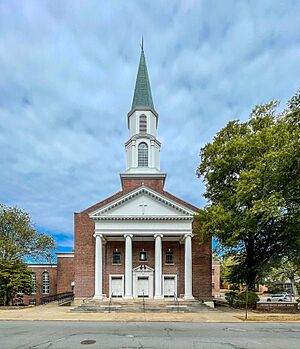Pulaski Heights facts for kids
Pulaski Heights is a part of Little Rock, Arkansas. It is in the north-central area of the city. People who live there often just call it the Heights. It's known for its nice homes, shops, and restaurants.
Contents
History of Pulaski Heights
Pulaski Heights was once a very fancy area of Little Rock. It became its own town on August 1, 1905. In the 1890s, only a few families lived in this wooded area. But when electricity and streetcars arrived, more than 300 families moved in. There was even a weekly newspaper called the Pulaskian made right in the neighborhood.
Pulaski Heights stayed an independent community until 1916. Then, its residents decided to join Little Rock. They became Little Rock's Ninth Ward. This gave them benefits like a fire station. Later, the Pulaski Heights area split into two smaller neighborhoods: the Heights and Hillcrest.
On March 31, 1960, a B-47 bomber plane had an accident over the neighborhood. Part of the plane was found in Allsopp Park. The plane had taken off from Little Rock Air Force Base. It was headed to Barksdale Air Force Base in Shreveport, Louisiana. Sadly, three of the four crew members did not survive. Two people on the ground were also killed in the accident.
Learning in Pulaski Heights
Mount St. Mary's Academy is a school that started in 1851. It moved to Kavanaugh Boulevard in 1908. When it moved, it stopped teaching boys. It also became known just as Mount St. Mary's Academy. This school is the oldest one in Arkansas that has been open continuously. In 1930, Little Rock Catholic High School was built nearby for Catholic boys.
Pulaski Heights Middle School opened for local students in 1908. It was at the corner of Prospect and Oak Streets. Today, these streets are called Lee Avenue and Pine Street.
Little Rock College was founded in 1908. It moved to North Tyler Street in the Heights in 1916. However, the school closed on July 12, 1930. This happened because of the Great Depression, a time when many businesses and schools struggled.
Fun and Recreation
Pulaski Heights has several parks. These include Knoop Park and Allsopp Park. Allsopp is a large park, about 150 acres. It was given by Frederick W. Allsopp. Knoop Park has been home to the Little Rock Water Works since 1886.
The Country Club of Little Rock was built in 1902. It is the oldest country club west of the Mississippi River. It is known for its special members. The club has an 18-hole golf course, a dining room, and a family center.
Building Styles
Many famous architects designed homes and buildings in Pulaski Heights. These include Charles L. Thompson and George R. Mann. George R. Mann also designed the Arkansas State Capitol. Most homes in the area are built in styles like Georgian, Tudor, Craftsman, and English Revival.
For a time, there was a rule that only white people could buy or rent homes in the neighborhood. This was unfair and was made illegal in 1948. The U.S. Supreme Court ruled against such rules in a case called Shelley v. Kraemer.
Famous People Who Lived Here

Pulaski Heights Today
Today, Pulaski Heights is known for its unique shops and restaurants along Kavanaugh Boulevard. It is also home to St. John's Seminary and the Country Club of Little Rock. About 30,000 people live in the area. The Ninth Ward is now called Ward 3. As of 2024, Kathy Webb represents this area.


